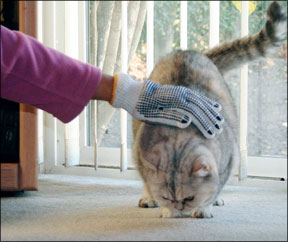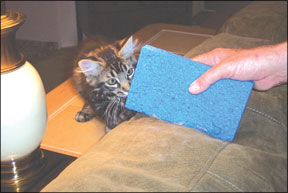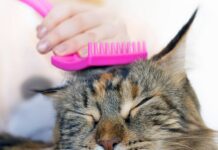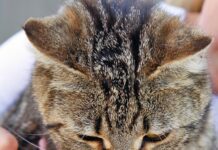With three shorthaired and five longhaired cats, Debbie Salerno, chairperson of the board for Maine Coon Cat Rescue in Hazlet, NJ, knows all about cat hair. “I find hair on the steps, on the carpeted cat tree, in the carpet in the hallway, wafting across the floor, and settled into the corners [of rooms] and around the bottom of the furniture,” she relates. When hair is not cleaned up, it tends to travel with Salerno to work: “The hair gets all over the furniture and then sticks to me, and it winds up in my car and sometimes in

Bev Caldwell
288
my office if I dont get it off.”
Admittedly, for some cat owners, wayward hair is not a big issue. For other owners, however, it is. “Cleanliness is a high priority for me,” explains Bobbie Williams of Beavercreek, OH. Williams, a volunteer for Maine Coon Rescue, will be hosting a wedding in her home soon and has the hair of four cats (two longhaired and two short-haired) to contend with for this event.
A Good Offense
The best way to attack a home hair problem is to remove loose hair from your cats coat before it hits the floor. Salerno recommends brushing regularly with a slicker brush, whether your cat is long- or short-haired. Short-haired cats often shed more than long-haired cats, vouches both Salerno and Williams, whose problem shedders are not their Maine Coons, but their shorthairs.
Of course, you cant possibly catch all pet hair before it falls out. So when it does make landfall, the following are ways to pick up pet hair as easily and thoroughly as possible.
Tackling Upholstery
Vacuuming is the first approach to removing cat hair from upholstery; however, if your vacuum isnt removing enough hair, you can try one of several other approaches.
Get Sticky – Lint rollers (a rolling brush that has tape “sticky side out”) work by adhering cat hair to the sticky tape. Manufacturers, such as 3M, make a pet hair roller specifically to pick up pet hair that comes in several sizes – from mini to jumbo. Pocket-sized packs of lint pickup sheets are also available for those owners who frequently find cat hair stuck to their clothing.
Tip: Forego the special rollers and use packing tape. Take a length of tape (a 12-inch section should be more than enough) and wrap the tape – sticky side out – around your fingers. Press the tape against any areas that you want to remove cat hair.
Attachments for Pets – Several manufacturers make special “pet” attachments for their vacuums. These usually consist of a rotating brush that works in concert with the suction of the vacuum. Pet attachments can be particularly helpful when the upholstery fabric is more textured. Hair tends to accumulate on the attachment itself, Williams heeds, so “clean the brush head of the [pet] attachment often.”
Damp Does It – For leather couches or very smooth, tightly woven fabrics (slick to the touch), clean first with a soft (non-rotating) vacuum brush attachment, and finish by using a damp cloth, a leather wipe (if its a leather couch), or a Swiffer pad. A common sponge works well, too.
Whats On Your Floor?
When vacuuming pet hair, use a High-Efficiency Particulate Air (HEPA) filter. This air filter traps particles as small as .3 microns and prevents them from circulating in the air. “The filters are about $30 [for my vacuum] but they help keep down dust and dander,” explains Williams.
To Bag or Not to Bag – Some pet owners feel the traditional bag vacuum is better for the capture and disposal of pet hair than a bagless vacuum. Their experience has shown that with a bagless vacuum, pet hairs can stick to the walls of the canister and wont

Bev Caldwell
288
shake out when the collection canister is emptied. Tip: If youre using a bagless canister system, Williams suggests rinsing the canister with warm water to remove hairs and any other clingy debris.
Odor Control – One new pet vacuum, the Eureka Boss 4D Pet Fresh, integrates baking soda into the vacuuming system to control odors in upholstery and carpeting. If you dont own one of these new vacuums, shake baking soda on your floor and vacuum it up for additional odor control. Keep kitties off the baking soda while youre doing this; baking soda can be toxic to cats if ingested in large quantities.
Hard Floors – If shedding is light, using a damp mop or Swiffer can be enough to control pet hair. In heavy shedding homes, sweep or vacuum first with a hard floor attachment and then finish with a damp mop or Swiffer to pick up remaining hairs. Tip: When mopping, use a cleaner that is safe for your cats. Cleaners with pine, which can be toxic to cats, should be avoided. Rather, Williams recommends that pet owners consider using a mixture of vinegar and water to clean surfaces.
Throw Rugs – Small area rugs can collect copious amounts of hair. Williams relates that in addition to regular vacuuming, she washes her throw rugs once a week. Tip: For maximum hair removal, vacuum throw rugs first, then air fluff them in your dryer before washing, wash then dry.
Errant hairs can wind up in the strangest places, including your walls. To trap the hairs (rather than get them airborne), Williams suggests using a damp cloth to wipe down walls, or if you like gadgets, try an electrostatic duster. The duster is made of a fabric that is electrostatically charged so it attracts hair and dust much like a magnet. When placed back in its slot on the vacuum, it spins itself clean and is ready for the next time you need it.
Practically speaking, there will always be some pet hair somewhere in your home. It is possible to keep up with the shedding using a few cleaning tricks, and if you like gadgets, there are a few out there that can make your job simpler or do the work for you.



